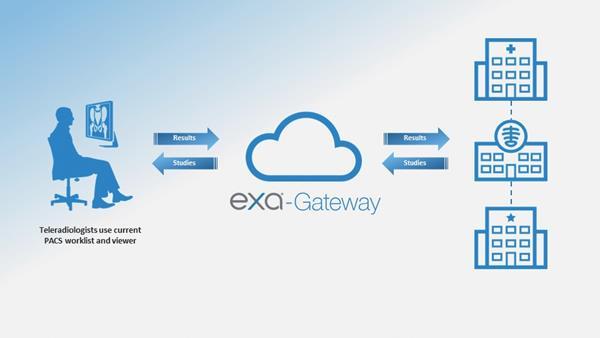BLOG: Exa Gateway Offers a New Way to Deliver Teleradiology

Exa Gateway connects hospital radiology departments, radiology practices and teleradiologists through technology and services to enable cost-effective and efficient remote reading capabilities.
The onset of the COVID-19 pandemic vastly altered the way of doing business for most industries, radiology included. Some facilities opted to keep their doors open and continued serving those in need of scanning services. Others were able to transfer some of the workload over to off-site imaging companies to help manage the inevitable deluge. These imaging companies did help prepare for the potential surge in patients by keeping imaging processes moving forward, but not every facility had this option, and the volume of imaging procedures fell short of expectations and in performance compared to 2019.
In this new climate, there is an increased demand to find new ways to handle the overflow of radiology studies and the surge in the number of patients needing scans. This necessitates a new way to deliver teleradiology. Catering to this need, Konica Minolta introduced Exa Gateway. Exa Gateway offers a cost-effective solution for secure remote reading that connects hospital radiology departments, radiology practices and teleradiologists through technology and services.
Addressing a Growing Need
By 2024, it is estimated that 0.5 billion diagnostic imaging examinations will be performed in the United States — this is three times higher than the global average. Teleradiology reading will account for 6 percent of these reads, according to data from Signify Research, an independent supplier of market intelligence and consultancy to the global healthcare technology industry. This will be driven in part by the high demand for off-hours reporting, which is necessitated by the insufficient capacity of in-house radiologists during standard operating hours. According to Signify’s data, off-hours reporting is estimated to have accounted for approximately 45 percent of the global teleradiology reading service market in 2019, and it has been a major driver of growth for many reading services companies.
Another driving growth factor is the use of cloud-based technology. The increased use of this technology makes implementing information technology for teleradiology less complex. “The benefit for hospitals and imaging centers in using cloud-based technology is that it bypasses the investment required for static IT architecture. It also removes geographical barriers, providing access to teleradiologists globally who simply require an internet connection and access credentials in order to provide a read/report,” explained Arun Gill, Signify Research analyst.
Exa Gateway offers a secure and cost-effective remote reading platform solution. Through Exa Gateway, studies are transmitted to the teleradiologist for interpretation and final reports are sent back to the originating site. It utilizes a facility’s existing PACS investment and environment, which minimizes the upfront costs. This combines a technology platform with a service that aligns radiology practices with teleradiologists.
Business Growth
As part of the Exa Gateway service, Konica Minolta provides the teleradiologist with new customers. Once contractual arrangements are in place, the Konica Minolta team will establish connectivity to each of the radiology practices’ PACS. It does not require changes to the current system for either party so teleradiologists can use their existing worklist and viewer. “A key benefit to Exa Gateway is a single connectivity pathway to all radiology practices included with the Exa Gateway service,” said Tim Kearns, Konica Minolta Strategic Marketing Manager, Healthcare IT. “This provides streamlined connectivity and reduced costs.”
This arrangement is a win/win for both teleradiologists and radiology practices. Imaging centers can add or start a teleradiology service that streamlines and reduces the cost of connecting with radiology practices. For teleradiologists, one connection provides a gateway to multiple practices, and is set up and maintained by Konica Minolta.
“By utilizing a facility’s existing PACS investment, Exa Gateway minimizes costs, streamlines connectivity and enables teleradiologists to use their current PACS worklist and viewer with which they are already familiar,” explained Kearns. “There is no additional strain on existing IT staff and resources. Hospital radiology departments can access teleradiology services on demand, providing the flexibility to manage fluctuating volumes. Radiology practices can implement remote reading capabilities with access to teleradiologists to handle overflow of studies or provide overreads and sub-specialty interpretations, enhancing their service to referring physicians and patients. Exa Gateway can be configured for both existing Exa customers and non-Exa users.”
Because the solution is part of the Exa platform, radiologists can take advantage of Exa's Zero Footprint viewer with full diagnostic toolsets and viewing capabilities. All that is required is a browser. With Exa’s Server-Side Rendering technology, the work is being done at the server and not the workstation. Large imaging studies, including 3-D mammography, can be opened immediately.
“As radiology departments and practices re-open and expand services to address the backlog in patient imaging, Exa Gateway provides a secure, efficient and cost-effective solution for remote reading capabilities,” concludes Kearns. “It is also a blueprint for the future of radiology reading, where teleradiology and remote reading will play a larger role especially as many communities and facilities address radiologist shortages and a lack of sub-specialists in radiology.”
Editor's note: This blog is the second in a series from Konica Minolta on technical innovation. The next blog will feature the virtual patient experience. The first BLOG: Zero-footprint Viewer with Server-side Rendering Pushes Imaging Forward During Pandemic, can be read here.



 December 10, 2025
December 10, 2025 









